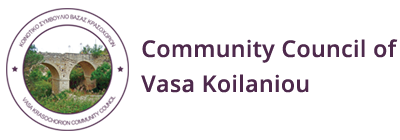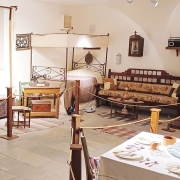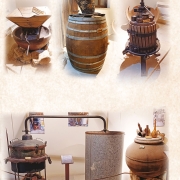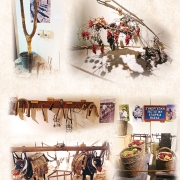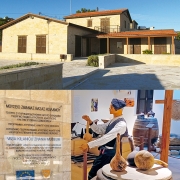The ecclesiastical museum of Vasa Kilaniou was created to preserve and display the cultural heritage of Hellenism and Christianity. The devotedness and love of the reverend presbyter Nicholas Panayiotou for the village’s ecclesiastic heritage, made him reveal the holly icons and the sacred heirlooms. They now decorate the chapel of Timios Prodromos and the museum.
The visitors, who are usually worshippers, can discover pieces of faith, devotion, and above all, pieces of holiness, as this holy island was blessed by the greatest Saints of our church, for example Holy Varnavas and Saint Timon.
In the exhibition area you can find holy icons, which are dated in the late 14th century and up to the 16th century. The oldest one is a hollow icon of Virgin Orans (late 14th century). The modeling of the sarcomata, the vivid gold brush strokes and generally the freedom of movements, which are presented by the artist are similar to the icons of the 14th century found in Cyprus.
The icon of Panagia Panachrantou comes from Constantinople. To the same artist are attributed the icons of Panagia Pantanassa and maybe the icon of Saint Varnavas. These icons are dated back to the second half of the 15th century and they have significant differences with the aesthetics and technique which dominate Cyprus at that era. During the late Byzantine era, the features are impressive and of an excellent technique. It is believed that the artist was a monk or a layman who fled for refuge in Cyprus after the fall of Constantinople in 1453.
The hollow icon of Saint George in the form of Diasoritis (passing through a lagoon and mountains) is dated back to the 16th century.
From the Great Deesis are rescued: the icon of Virgin Mary, Saint John the Baptist, Apostles Peter and Paul, Archangel Michael and Gabriel. We must note that to the same artist is also attributed the holy icon of Saint Timon. He appears wearing a tunic and a himation and he gives his bless. These icons are dated to back to the mid 16th century. Their aesthetics and technique classify them into the Cretan School. They are defined by serious features, vivid characteristics and color variations. The portable icons of Jesus the Savior Saint Marina, Saint Kiriaki, Saint John the Baptist, the right sanctuary door showing Saint Spyridon, and the sanctuary doors with the Annunciation of the Virgin Mary and Saints are attributed to another artist. His main characteristics are the pale faces, the curved eyebrows, the finesse and the harmony of the colors. The icons of Saint John Theologos and John the Bapstist belong to Solomos Thitis who was a priest. He signs in gold ink on the icon of Saint John the Baptist who is depicted full face and with a slight inclination of his face on the right side. Unfortunately the date is not shown because of the damage that is caused on the icon. Another signed icon of the same artist, which is exposed in Kykkos museum, leads us to the conclusion that Solomos acted around 1640. his art is defined by the soft modeling of the sarcomata, the sign of reverence on the expressions of the face and the “intense movement” of the features define his art. He also likes painting relief nimbuses decorated with plants (a characteristic of all the artists of the 17th century).
The veneration icons of Saint Dimitris (1832), Saint Irene, Saint Kononos, Saint Neofytos, Saint Ioannis Damaskinos and Saint Barbara, Saint Antonios, and the icons of the Presentation of the Virgin in the Temple and the Resurrection of Christ are attributed to the hagiographer Parthenos. On the backside of the icon of Saint Neofytos there is an inscription of the artist, which refers to the donors: deesis of Theodola and child Ioannou and his wife and children.
The Greek citizen Argiros Menikou, inhabitant of Asproyia, was married with Rodia or Sofia and moved in Vasa Kilaniou. He brought with him an icon of Ayioi Pantes (All Saints) (1883). It was a work of the deacon Christoforos who has given it to the church of Osios Varnavas.
The same artist signs a unique icon, which depicts a scene of a miracle of Saint Merkourios who saved Caesarea from Ioulianos Paravatis after an invocation of Saint Vasilios. It is said that this is the miracle that lead to the tradition of the Vasilopitta (traditional pie) with the coin in it. On the same icon there is also a very small depiction of Saint Catherine. The feast of Saint Merkourios and Saint Catherine is celebrated on the same day (25 November). The second icon of Osios Varnavas is dated back to the 19th century. In 1856 Argiros has ordered from the deacon Charitonas, who lived in the church of Chrisoroyiatissa, a number of icons, such as: the Nativity, Annunciation and Dormition of Virgin Mary, the Raising of Lazarus, Vaiforo, the Crucifixion and the Holy Trinity. The donor Argiros Menikou is depicted kneeling and in old age on the right side of the icon of the Holy Trinity. He wears the traditional pants (vraka) and a shirt. In 1938/9 the late Yiannis tou Ktori covered with black paint the portrait of Argiros because he believed that he was a Shylock. In 1860 Charitonas has painted the icons of Saint Simeon, Jesus of Navi and the 40 Virgins, who are celebrated on 1st September. In 1865 he painted the icon of Saint Onoufrios and in 1875 the icon of the Last Supper. He also overpainted the icons of Panagia Pantanassa (second half of the 15thcentury) and the icon of Saint George (16th century) except from the faces. A notebook with historical and medical notes which was found in 1821-1845 and it was known as the “defteri tou Gerarkirou” (notebook of Gerarkiros), belonged to Kostantinos Menikos and after his death it was given to his close relative Argiros Menikos.
The icon of Saint Charalambos is attributed to the Greek artist Vasilios (19th century) who used to work in Cyprus. Some Cypriots who visited the Holy Land brought back with them a number of icons, such as the icon of Saint Charalambos (late 19th or beginning of the 20th century) and wax eggs (1930), which they donated to the church of the village.
There is also an important collection of ecclesiastical equipment, which includes a mediaeval silver spoon, which was used as a holy spoon of the chalice. In its cavity we can discern a seal of the dynasty of Lusignan. Its shape is oval and it represents a lion standing with a crown on his head and on the left side is written the letter “M”.
The spoon is twisted and in the center it is decorated with a king’s head. At the end there is a scene of some birds kissing each other. Similar chalice spoons were given as a present to several monasteries and churches during the wedding of Jacob Lusignan the second with Catherine Cornaro (1472). Two fine silver censers and a chalice are dated back to the 19th century. The chalice base has an incised plant ornament and the Islamic influence is more than obvious. The silver “eptafoti lichnia” (lamp) is very rare. It was made in 1908 by the goldsmith S.A. and it was used for the service of Artoclasia and the extreme unction. There are also two silver sacerdotal clasps dated back to the 18th-19th century and which are decorated with dragons. Two of them have also an incised depiction of Saint Helen and Constantinos holding the Holy Cross. The feretories of Saint Panteleiomon, Saint Philippe and the scalp of Osios Varnavas (1895) are dated in the 19th century. There is also a small ecclesiastical bell, which belonged to the fleet of Napoleon. According to an old tradition, some pirates sacked the fleet in the LivikoSea and they sold a carpet and the bell to the bishop of Paphos. Thereafter, the monk Gedeon donated it to the church of Vasa Kilaniou.
There are no manuscripts left from the Byzantine era. There used to be a parchment Gospel book which belonged to Osios Varnavas. Two leaves of another parchment Gospel book of the 14thcentury, where found in the house of the late Hampis and are now kept in a private collection in the village. Unfortunately, two post-Byzantine handwritten Masses of Osios Varnavas dated in 1639 and 1818 are lost.
The first printed books appear in the late 15th century and they come from printing houses in Venice. For a short period of time both printed and handwritten books are used, but at the end the first dominate over the handwritten. There is also a rich collection of ecclesiastical documents which includes incunabula with leather binding and which is dated in the 16th-19th century. The most important are the one of December of 1551, the Gospel book of 1754, the one of July of 1774 and the order of service of Saint Therapontos of 1801.
In some incunabula there are handwritten notes (some of them have a date) which refer to donations or purchases. These notes are very important as they reveal the social, economic and religious status of the people of that era (18th-20th century).
The documents of purchase dated in 1896, the handwritten book with the names of the people that owed money to the church of Osios Varnavas and some receipts of taxes payments consist significant evidence for the lost church of Osios Varnavas.
In the display cases of the museum’s exhibition area and of the chapel of Timios Prodromos are exhibited canvas works such as the big Russian epitaph (19th century), sacerdotal belts made of wire and beads (18th-19th century), glass coverings and canonicals of famous priests such as the monk Papaxenofontas (1890-1964), the priest Ioannis Kostantinides (1899-1993) and the priest Nearchos Yiallourides (1914-1993).
An important collection of more recent documents, letters and circulars that was found in the village was dated in the 19th century (1878-1960). All these provide us significant information not only for the history and the social status of the Greek-Cypriots, but also of the entire nation. These documents also reveal the constant interest of the local church to help and support its people during this difficult period.

































The Zivania Museum of Vasa Koilaniou was founded on the initiative of the Vasa Koilaniou Community Council and with the assistance of the EU in 2010 – 2012, in the “Potsos” area and on the site of the former Vasa community stadium.
The Museum was funded by the European Agricultural Fund for Rural De-velopment and the Republic of Cyprus within the framework of the Rural Devel-opment Programme 2007 – 2013 and the European Agricultural Fund for Rural Development, “Europe invests in rural areas”.
The inauguration of the Museum was held by the former President of the Re-public of Cyprus, Mr. Nicos Anastasiades, on 10 July 2013, in the presence of the late Archbishop of Cyprus Chrysostomos II, the then Minister of Education and Culture, Mr. Kyriakos Kenevezou and other ecclesiastical, state and local dignitaries.
The reason why the unique Zivania Museum in Cyprus was built in Vasa is that the village was one of the most important wine-growing villages in Cyprus, which in the past was full of vineyards. This entire tradition of viticulture was preserved as the pride and joy of the residents and samples of it were transferred to the newly established Museum with the ultimate
goal of safeguarding them, but also of dis-seminating them to young people who did not have the opportunity to experience this way of life of their grandparents and ancestors.
The Museum is divided into three parts. In the first part, where agricultural tools and the means of harvesting, storing and exporting zivania are exhibited, we will see the journey of a winegrower.
Initially, we will see the means of planting the vine, the means of pruning, the means of cultivating it, the way of harvesting the grapes, their transport to the houses, the grinding and finally the distillation of zivania. In addition to the agricultural tools, we will see in this part, other interesting objects from the lifestyle of the inhabitants.
Useful tools and other objects for the course of planting the vine and for the production of wine and its derivatives
- To prepare the soil for planting the vine, the ‘Kuspos’, the Xinari, donkeys for transporting stones with stone slabs and building the walls using the dry stone method were needed.
- To plant the new vineyard, thin rods were needed for the marks that would be placed on the vine, the «ladder» for opening the pits, containers for transporting water and the cistern.
- To cultivate the vineyard, two animals were needed (donkeys or oxen) and the wooden plow (Hesiod’s aletron) which had a metal coulter on the front that furrowed the soil.
- For the vineyard harvest, baskets, baskets with the grapes, donkeys were needed to transport the grapes to the house or to the Zigaria (pilantza) for sale. The grapes were cut by hand or with a knife. The baskets were emptied into the grinding machine, where they were ground into jars.
- For the distillation of zivania, a cauldron (boiler) and a basin were needed, which were connected to it by a copper tube in the shape of an arch. The basin was filled with cold water. Inside the basin there was a cylindrical copper container that ended in a coil.
- The press is a round instrument, where inside they placed marcs which were pressed rotationally to extract all the juice from the grapes.
- The basin (vourna) was used to press the grapes and thus extract the grape juice (musto).
- The pilantza (scale) was used to weigh the grapes that were in the baskets.
